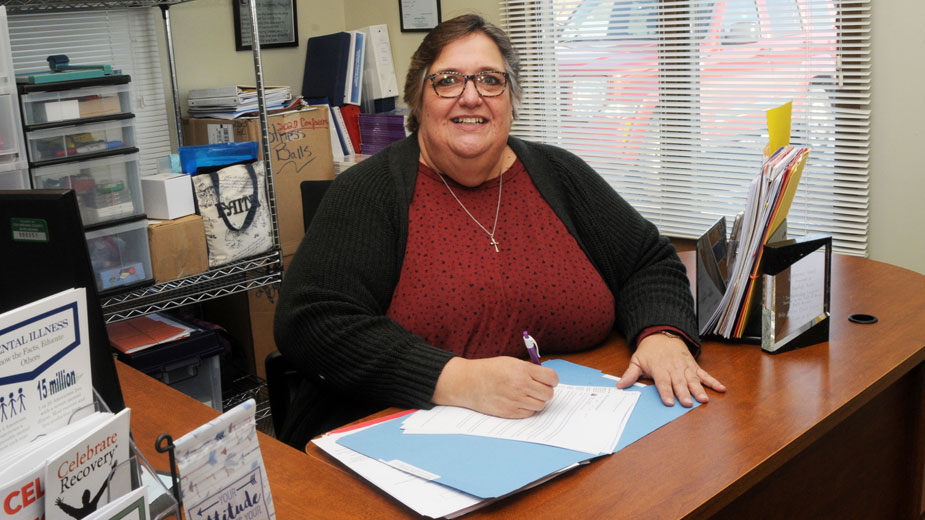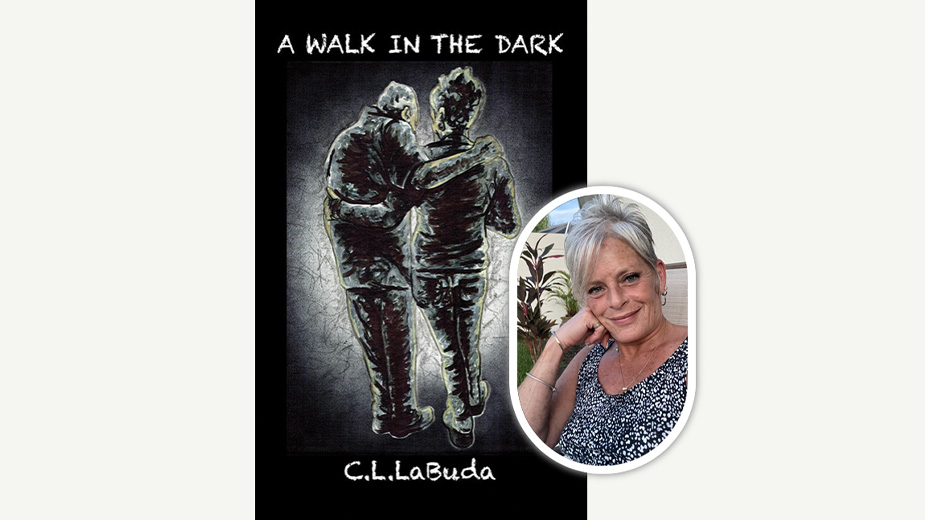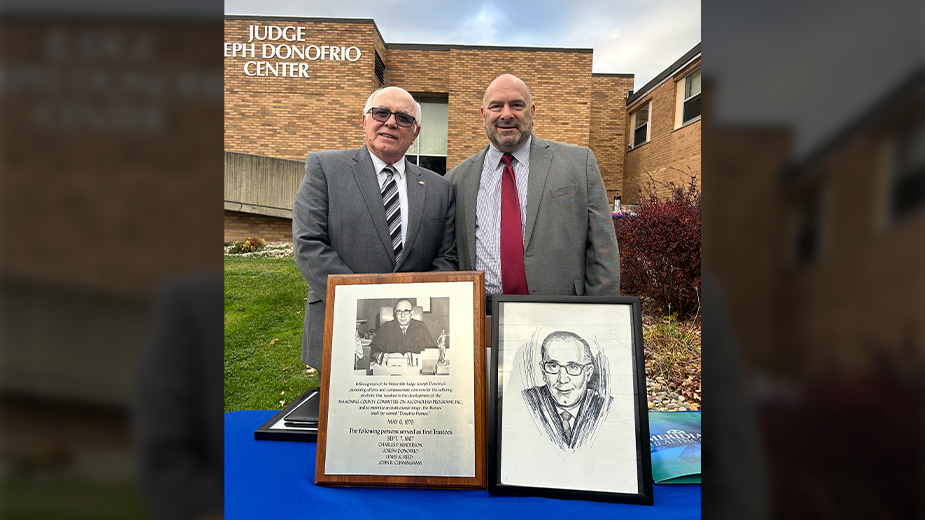Suicide Hotlines, Counselors Save Lives
By Lisa Solley
YOUNGSTOWN, Ohio — Maureen Waybright had lost all hope. Wanting to end the pain that enveloped her, she wrapped a wire around her neck.
She hadn’t tightened the wire with the pliers clutched in her hand when she dialed the crisis hotline at Help Network of Northeast Ohio.
As a crisis counselor spoke to the 30-year-old mother of two, emergency responders were summoned and a counselor waited for Waybright’s parents to arrive.
“My kids were upstairs sleeping. I didn’t necessarily want to die; I just wanted the pain to go away,” Waybright recalls. “I was more hopeless and it was getting harder and harder to fight. All hope was gone.”
Waybright is now 57 and has been a recovery coordinator for the Columbiana County Mental Health Recovery and Services Board. It wasn’t the first time she had used the crisis line, which she calls a safety net of people who will listen and let people know there is someone out there who cares. “The crisis line is a lifesaver,” she says.
Help Network, formerly known as Help Hotline, oversees the crisis hotline (330 747 2696) and the 211 resource and information line for Ashtabula, Columbiana, Mahoning and Trumbull counties. The lines are open 24/7/365. On Dec. 13, it was announced the Federal Communication Commission would establish a national three-digit line, 988, for those seeking mental health assistance.
Crisis calls and calls to the Help Network received more than 162,000 calls in 2019, providing both crisis support and information.
“We are your first call for help or your last call,” says Cathy Grizinski, associate director and chief clinical officer for Help Network of Northeast Ohio. “We just want people to know someone is here to listen and to let them know someone cares.”
Waybright’s story has a different ending than 1,836 Ohioans who died from suicide last year, up 45% from 2007. The Ohio Department of Health reports that suicide is the leading cause of death among Ohio children ages 10 to 14 and the No. 2 cause for those between 15 and 34, according to the agency.

Grizinski points out that the region does not mirror the state’s numbers when it comes to suicide deaths for ages 10 to 14, but finds the sharp increase in deaths concerning.
“We’ve had an increase in kids talking about suicide, but no increase in acting on it,” says Joseph Shorokey, CEO of Alta Behavioral Healthcare. “This should put everyone on guard.”
Local mental health experts credit increased prevention efforts in schools as well as increased marketing of available resources, including Ohio’s crisis line, as some of the reasons the state numbers aren’t being mirrored locally.
Grizinski says crisis counselors average four to five calls daily regarding suicide. Between July 2018 and October 2019, counselors handled 1,830 suicide calls from callers in Columbiana, Mahoning and Trumbull counties.
Eighty people have died this year from suicide through October in the three-county area. Two of those deaths were youths ages 11 and 17.
The crisis text line was put into effect in Ohio in June 2016. Users can text 4hope to 741741 to be connected with a crisis counselor. Ohio uses the 4hope keyword for tracking.
According to statistics from the Ohio Mental Health and Addiction Services Board, Ohio’s system is the most-used in the country with 22,386 conversations to date.
“We really tried to work with our partners in the schools and treatment agencies to get word out to kids about the crisis text line they can access any time from their phone,” says April Caraway, executive director of Trumbull County Mental Health and Recovery Board. “I think that’s been a deterrent maybe for someone who feels isolated. They can at least reach out for that text line help.”
Shorokey says counselors at Alta, who work mainly with adolescents, are seeing kids as young as 8 to 10 years old say, “I hate my life and I want to be dead.”
He admits they may not know the full implication of the statement, “but they’re communicating that something is going on in their lives that they are feeling hopelessness,” he says. “That is something we can’t ignore.”
Professionals from Coleman Professional Services respond to people at Trumbull hospitals who need to be screened for mental health, drug and alcohol or other issues. They have recorded 2,269 screens that have resulted in 1,300 hospitalizations.
Katie Cretella, director at the Coleman Access Center, says more mental health screenings are being done on children in the emergency room. Two-hundred of the screens were for children.
She says issues with families, such as arguments are common, and many reported they were doing poorly in school.
“Social media does play a role,” she says. “I don’t have enough data to confidently say it is a main reason, but it’s apparent there are effects.”
Local professionals agree that social media and bullying are leading factors for the increases in suicide attempts and deaths among children and young adults.
Shorokey points out social media can make kids feel devalued when they see posts reflecting how others have the “perfect” life and their lives don’t square up.
“Bullying is a big issue. I remember when I was young and if something happened in school, I could come home and escape to my room,” he says. “But now there’s no escape from the commentary on social media and it piles up and adds on to feelings of isolation and depression.”
Shorokey admits this is a conclusion that may be unpopular, but he believes the educational system contributes by the demands being placed on kids to be academically proficient at far younger ages.
“This is occurring at the expense of social and emotional development,” he observes.
“Suicide is one of the last taboos in our society,” says Duane Piccirilli, executive director of the Mahoning County Mental Health and Recovery Board. “People don’t want to talk about it. Talking about it is not a weakness, especially for men, it’s not a weakness. We need to start having these conversations.”
Stigma is something Waybright knows all too well. She was first hospitalized in a psychiatric unit when she was 23 and diagnosed with severe depression with possible borderline personality disorder.
“I totally didn’t want to have a mental illness diagnosis. I didn’t want to be called crazy or nuts,” she says. “I was a Girl Scout leader and a Sunday school teacher. I was in such denial.”
Waybright recalls times she was hospitalized for surgeries and people would send flowers and food from church parishioners. “When I was in the psychiatric hospital, there were no flowers, there was no food from the church.”
Piccirilli says society needs to start normalizing mental health care. “If someone goes for cancer treatment, people talk about it and want to help. The same should be done for depression. People think it’s self-imposed and it’s not,” he says.
Waybright says the stigma of suicide has been broken down some, but work still needs to be done. Even in the professional world, more education is needed.
Stigma is an issue that crisis counselors at Help Network avoid. They listen, de-escalate and let people know someone cares. But sometimes nothing works.
Nancy Clausen has been a volunteer for five years. While she has taken numerous calls and has helped thousands, there is one that she says will never leave her.
Parents of a young man had called to talk because they were worried he was he was going to hurt himself.
“As I was talking to them, the young man went to his room and hanged himself while we were on the phone. One of them found him while I was still on the phone. It was traumatic,” Clausen says.
In many cases when someone dies, experts say people are apt to look for answers or blame themselves.
“There’s so many things that led up to it,” Caraway says. “You can’t keep trying to figure out what was that one thing because there’s never that one thing.”
Grizinski says anyone who is mentioning suicide should be taken seriously.
“Listen to them and ask how you can help or why do you feel that way. The last thing you want to do is dismiss their feelings because they will just shut down more,” she says. “They want to know in that time that someone cares.”
So far this year, there have been 34 suicide deaths in Mahoning County, ranging from ages 11 to 86. Columbiana has had 18, of which 10 were over the age of 50.
In Trumbull County, 28 people died from suicide in 2018, and so far this year, 24 people have completed suicide, with the youngest being age 17.
Grizinski says suicide deaths among people ages 25 to 44 continue to be the highest, although suicide deaths among the elderly population are rising.
White males dying by suicide is disproportionately higher statewide. The use of a firearm is the leading method of death, followed by hanging.
The number of elderly suicides has increased in Trumbull County, Caraway notes.
“We know from our work with the coroner’s office that depression, isolation and medical issues are key factors,” she says.
Trumbull statistics show that 67% of those completing suicide are married, while 25% are single and 8% are divorced. A firearm was used 74% of the time and 22% are completed by hanging. The majority of suicides occurred on Wednesday, Friday and Sunday.
While the holiday season can bring about depression, especially for those who have lost loved ones, are missing family members or feeling isolated, the majority of suicides occurred in March, according to Trumbull statistics.
Grizinski agrees the day of the week and monthly statistics are similar to what she sees. “We see higher rates of suicide in the spring. I think that after the holidays the expectation is that everything is well and good and that’s when people fall through the cracks,” she says.
Experts say the suicide number may be higher because many of the overdose deaths may be suicides and not accidental overdoses. Shorokey suspects that is the case, but says the area doesn’t have the resources or funds for coroner’s offices to investigate.
Caraway says it’s hard to know for certain as statistically only about 30% of people leave a note. “There certainly is a crossover with substance use that puts people on either side of the deaths we’re seeing.”
Waybright is an example. She took more than 30 pills and was drinking in 1998 during her last suicide attempt. She didn’t call the crisis line that time, but a call to a friend to say goodbye saved her life.
Since then, Waybright says she has learned about her bipolar disorder with traits of borderline personality disorder. She sees a psychiatrist monthly and relies on her faith and a strong circle of support.
As a recovery counselor, Waybright goes into schools and tells her story. And because she’s walked the road of loneliness, she doesn’t hide it from kids. Today, she tries to offer hope.
“We’re all born with a little bit of courage in us. All you have to do is reach in and grab a tiny bit of courage and tell someone, ‘I need help;’ just those words.”
Copyright 2024 The Business Journal, Youngstown, Ohio.


